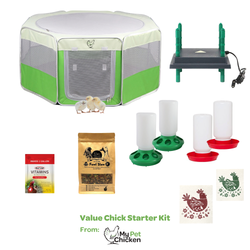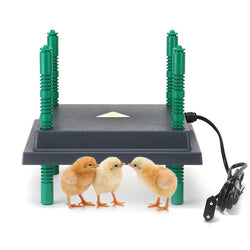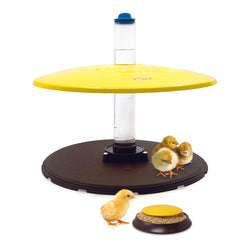What should I consider when choosing a waterer for my flock?
Back to blog
As you probably know by now, it's not a good idea -- at all -- to simply give chickens a bowl of water like you would a dog or a cat. They'll dirty it; they'll step in it and tip it over; they may even unintentionally poo in it. Here are 7 important questions to ask yourself when choosing a waterer for your flock:

Traditional-style waterer

"Fun and Funky" chick at a cup waterer.
-
How many thirsty birds do you have?
You need to make sure there is adequate access to water for all the birds in your flock. If you have a large flock but only one small waterer, that doesn't allow many chickens to drink at one time. There's a possibility that the chickens lowest on the pecking order could literally be bullied into dehydration. While you may be willing to fill your waterer often, in a situation like this, you would still want to either get a larger waterer or provide more than one. If you choose a nipple-style watering system, we recommend at least 1 nipple for every 5 birds, and nipples will need to be a minimum of 6 inches apart (though we prefer 7 inches or more), so that each nipple will be accessible to your flock simultaneously.
-
How big are your breeds?
A trough or hanging waterer should be at approximately chicken-shoulder height, while a cup or nipple system should be at head-height. You want a trough waterer to be as high as possible (so it gets dirtied less), but not so high that it's difficult for your birds to reach. Usually, about 6 inches above the ground is a good place to start. Nipple and cup systems are most comfortable for chickens to drink from when they're positioned so that they're more or less at beak height. Do make sure EVERY bird can reach water. If you're planning to have a mixed flock of both bantams and large fowl birds and multiple waterers, make sure at least one waterer or enough nipples are low enough for your bantams to reach. -
What will actually fit?
Make sure the waterer you select will work with your chicken coop/run setup -- you obviously don't want to choose something that won't fit through your coop door, for instance! -
What's your style?
- Traditional-style waterers have a simple, ingenious design with a reservoir on top of a round tray. They are usually an inexpensive watering option but require manual filling, can get dirty easily, and therefore, need to be cleaned periodically.
- Trough waterers are just reservoirs that attach to the side or corner of the coop, run, or brooder. These waterers are uncomplicated and convenient, but are usually smaller and work well for flocks with just a few birds, in injured bird coops, or in a quarantine coop.
- Nipple waterers feature a valve that chickens must tap in order for water to flow. These waterers solve the problem of the water getting dirty or soiled, and depending on the attached reservoir may need to be filled less frequently than other traditional or hanging types of waterers. If attached to a pressurized hose, some nipple waterers fill automatically.
- Watering cups, like nipple waterers, have a valve that must be tapped for water to flow, but also feature a small cup beneath the valve to allow for some water to be retained. The water in the cup may be more prone to freezing than nipple waterers or higher-volume traditional waterers.

Traditional-style waterer
-
How much work do you want to do?
As discussed above, each type of waterer has its own pros and cons. If you choose a traditional or hanging waterer, how often do you want to refill it? Each adult chicken will drink about one pint of water or more per day (more during especially hot days). So if you have a flock of 25 chickens and you plan on having just one 3.25 gallon waterer, you'll need to refill it about once a day. However, if you choose the 6.25-gallon waterer, you'd only have to refill it once every other day. Non-pressurized nipple watering systems will also require periodic filling, but can be attached to large reservoirs to decrease the number of times refilling is needed. Pressurized nipple watering systems will not require manual filling, but make take more time and cost more to plan and install. -
What's winter like in your area?
You'll want to make sure your birds have access to water at all times---so don't let that water freeze! If you live in cold winter areas, you'll probably want to plan for some sort of heating capability for your waterer. Waterer heaters come in 2 main styles: 1) A plate style, which goes underneath a traditional waterer, or 2) A submersible style, which is dropped into the waterer's reservoir.

"Fun and Funky" chick at a cup waterer.
-
What's the budget for this project?
Watering systems can range in price from a few dollars to hundreds of dollars depending on the size of your flock and the style of waterer you choose. Your personal budget will certainly play an important role in helping you choose which system is best for you.



